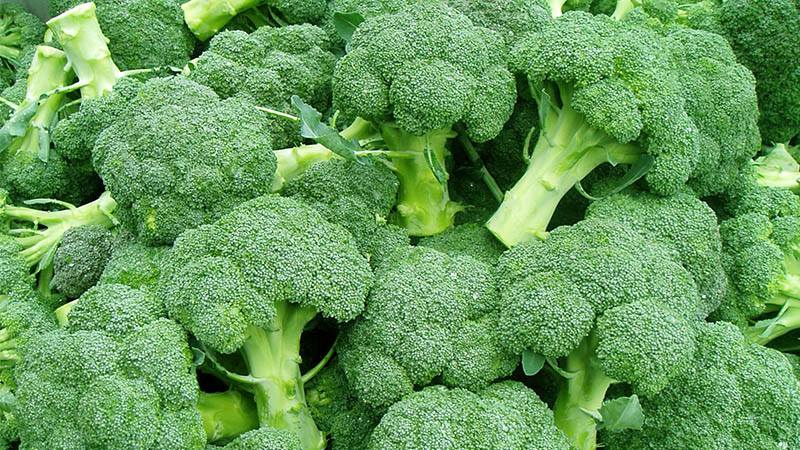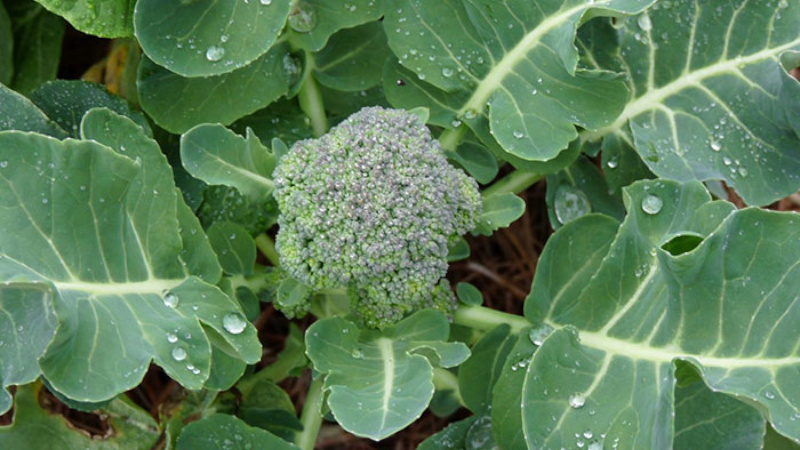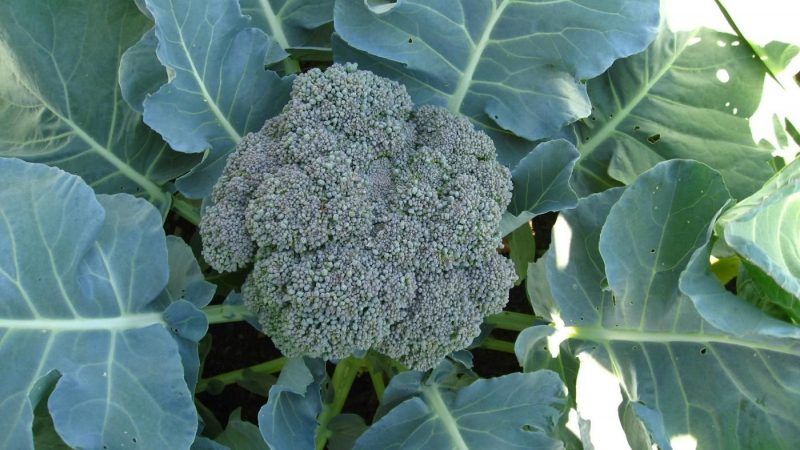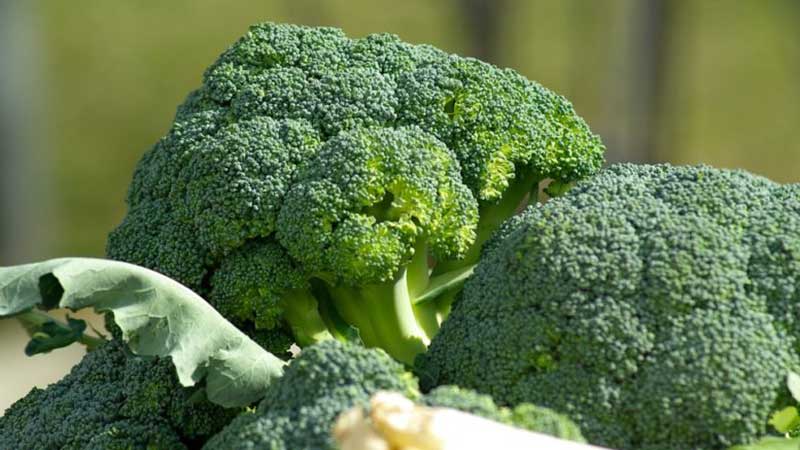Step-by-step guide on how to grow broccoli at home correctly
Broccoli, or asparagus cabbage, in terms of the content of vitamins and minerals surpasses other varieties of cabbage 2-3 times. It has a mild taste and is used in baby and diet food. This article will tell you how to plant and grow broccoli at home, and what will help you get a bountiful harvest.
The content of the article
Is it possible to grow broccoli at home
An unpretentious annual culture does not require special care and grows even at home. Cabbage is grown under the roof all year round.
Heads of cabbage in the open field are obtained from 300 to 1200 g, when grown on a balcony or at home, their weight will be halved.
Create a suitable environment for broccoli. The main conditions are lighting, sufficient humidity, optimal temperature and correctly selected soil.
Temperature
Cabbage is a cold-resistant crop that can withstand frosts down to -5 ° C. It is resistant to heat and reacts calmly to temperatures above + 25 ° C. For abundant yields, they maintain from +15 to + 20 ° C.
Humidity
The moisture-loving plant is watered every 3-4 days. Lack of moisture will make the heads of cabbage small and tough, and excessive watering will lead to root rot. Moistening the soil within 70%, and the air - about 85% will provide the gardener with a harvest of strong and juicy heads of cabbage.
Lighting
Broccoli loves sunlight and does not require shading. When grown in winter, additional lighting devices are used during the day.
It is interesting:
The best ways to freeze white cabbage for the winter at home.
How to prepare dried cabbage and where to use such a preparation.
Variety selection

It is important to choose the right variety. Early greenhouse species are suitable for home cultivation..
Popular:
- Stromboli. Ripening period 60-70 days. The weight of a dark green head of cabbage is about 400 g. It easily tolerates the summer heat.
- Kezzie. Ready to harvest in 70-80 days. This variety is resistant to diseases and has impressive heads of cabbage - about 1 kg.
- Vitamin. Small, 300-400 g heads of cabbage are distinguished by a high content of vitamins and protein. The crop is removed in 75-85 days.
- Quint. Ripening period 80-90 days. Heads of cabbage weighing 900 g. Cultivated at home at any time of the year.
Choosing a place for growing
A windowsill, a balcony, a glazed loggia are suitable for growing cabbage. It is desirable that the windows face the south or east side - so the sun's rays will give the right amount of light.
If the balcony is not glazed, take into account the seasonality of planting. In winter, it will not work, but in the spring and summer, the conditions will approach natural.
Preparation of planting material
To breed broccoli at home, the seeds are first processed:
- For 20-25 minutes. immersed in hot (50 ° C) water, then for 1-2 minutes. - into the ice.
- Soak them in a solution of potassium permanganate (1 g per 1 liter of water) for 8-10 hours.
- Placed in a two-day infusion of wood ash (1 tablespoon per 1 liter of water) for 6-8 hours.
- Rinse with clean water and leave for a day on the shelf on the refrigerator door.
- Dry on a clean cotton towel.
Store-bought seeds are already processed and do not require soaking.
Container
For the cultivation of cabbage, two types of containers are prepared: for seeds and growing seedlings after transplantation:
- The seeds are sown in boxes 50 cm long, 30 cm wide and 25 cm high. Drainage is placed on the bottom of the dish.Before use, it is treated with a pink solution of manganese.
- Pots 45 * 45 cm in size, boxes with a depth of 40 cm or old buckets are used as containers for growing adult plants.
The soil
The substrate in which the seeds are germinated is different from the mixture for permanent growth of cabbage... It includes in equal proportions:
- garden land;
- sand;
- humus;
- peat;
- wood ash.
Two days before sowing, the prepared substrate is watered with a dark purple solution of potassium permanganate.
The soil for transplanting seedlings is bought ready-made or mixed independently. For this you will need:
- garden land - 10 kg;
- ash - 1 kg;
- lime - 200 g;
- sand - 200 g.
To disinfect the earth, it is calcined in an oven at + 100 ° C. The procedure is carried out two weeks before using the soil. This interval is necessary to restore microflora.
Cabbage loves loose, light earth of neutral acidity. The day before planting, the soil is moistened, nitrogen fertilizers are applied and loosened to saturate with oxygen.
Sowing technology
At home, cabbage is grown by the seedling method. Initially, seeds are sown, then the seedlings are transplanted.
Sowing seeds
Sowing order:
- In the substrate in prepared boxes, grooves are made at a distance of 5 cm from each other with a depth of 1-2 cm.
- The processed planting material is sown at intervals of 2-2.5 cm.
- The boxes are covered with glass and placed in a bright place at a temperature of + 18 ... + 20 ° С.
- After 5-7 days, as soon as shoots appear, the glass is removed, the air temperature is lowered for a week to + 10 ... + 12 ° С. Then it is increased to + 16 ... + 20 ° С.
- Water the seedlings every other day in small amounts. The earth is kept moist and loose.
- After the appearance of the second leaf, sluggishly growing shoots are fed with a solution of ammonium nitrate, superphosphate and potassium chloride - 20 g per 10 liters of water.
Seedlings are kept on well-lit windowsills; daytime lamps are added if necessary. The required humidity level is maintained by spraying.
Important! Once every three days, turn the boxes in different directions to the sun and change their places - this will help to avoid stretching the sprouts.
After two weeks, the seedlings are thinned out, removing weak specimens. This will give extra food and space to the others.
Transplanting seedlings
From sowing to the day of transfer of seedlings, 35-45 days pass.
Plants are ready to move to a permanent place when 5-6 leaves are formed.
Transplant procedure:
- Depressions are made in the prepared containers. In long boxes the distance between the pits is about 35 cm. In pots and buckets - in the center.
- From the pre-moistened soil, sprouts with a root clod of earth are taken out.
- Make a dive, pinch off the main root.
- The seedlings are placed in recesses, sprinkled with earth to the bottom sheets and slightly compact the soil.
- The containers are placed on pallets with water, the reserves of which are regularly replenished.
- As the broccoli pots grow, they are pushed apart so that they do not shade each other.
Further care for broccoli

After transplanting, broccoli is looked after like an ordinary houseplant: watered, fed, monitored humidity.
Watering
Water the seedlings with a moderate amount of water in the root area. The soil is moistened 15 cm deep... Frequency - 1-2 times a week, in the morning. In the hot summer season, cabbage leaves are sprayed from a spray bottle in the evenings.
Broccoli is a moisture-loving plant. With insufficient watering, the heads of cabbage will grow small, with bitterness. But constantly damp earth threatens with rotting of the root system. The optimum moisture level is achieved using pallets filled with water.
Top dressing
Two weeks after transplanting, the plants are fed. For the first time, 2 tbsp. l. urea in 10 liters of water. Add 700-900 ml of the product per plant at the root.
The second feeding is carried out 15-20 days after the first. Take 100 g of chicken manure per 20 liters of water and leave for 2-3 days. The volume and method are the same as for the first feeding.
At the beginning of the formation of inflorescences, mineral fertilizers are applied in the following composition:
- water - 10 l;
- superphosphate - 40 g;
- ammonium nitrate - 20 g;
- potassium sulfate - 10 g.
Watering rate - 600-800 ml per plant.
After the first harvest, a fourth dressing is applied. It stimulates the formation of new inflorescences at the cut of the central part. In 10 liters of water, 30 g of potassium sulfate, 10 g of ammonium nitrate and 20 g of superphosphate are diluted. Enough 0.5 liters per plant.
The appearance of plants determines the lack of nutrients... Lack of nitrogen slows down the growth of broccoli, the lower leaves turn yellow and fall off. If the leaf plates turn bronze and the edges begin to dry, this indicates a low potassium content. Reducing the amount of boron makes the stems thin and weak.
Loosening and hilling
After each watering, the soil is loosened to a depth of 8-10 cm. Additional saturation of the soil with oxygen will help to avoid waterlogging. The stems are spud one day after feeding. Sprouted weeds are removed.
Protection against diseases and pests

When grown at home, broccoli is less susceptible to pests than in the garden. For prevention, dill is planted with cabbage to scare away cabbage aphids. Celery, growing nearby, will save you from the whites and earthen fleas. Peppermint will help prevent whitefly caterpillars.
If pesticides are used, then they do this no later than three weeks before the set of inflorescences. Formed heads of cabbage are sprinkled with wood ash, mixed with shredded tobacco.
The main disease that threatens plants at the seedling stage is blackleg. It occurs with abundant watering. The blackened stems are removed, the soil is watered with a pink solution of manganese (3-5 g per bucket of water) or "Fitosporin". After the seedlings are not moistened for about a week.
Peronosporosis Is another common cabbage disease. Light yellow spots cover the leaf plates, a white bloom appears below. Seedlings are sprinkled with a mixture of sulfur and lime or treated with Topaz solution.
Subject to all stages of processing and planting, the risk of disease is minimal.
Read also:
The best ways to keep cauliflower for the winter at home.
Harvesting for future use: is it possible to freeze Peking cabbage for the winter.
The best ways to freeze white cabbage for the winter at home.
Harvesting

Formed heads of cabbage are harvested in the morning. They are then the juiciest. The central shoot is cut before the flowers bloom. The readiness is determined by the density of the inflorescences - they become a little loose. Opened buds are not good for food.
Attention! It is recommended to cut off the green head, not the open one.
The part of the stem near the inflorescence up to 10 cm is also quite soft and suitable for consumption.
After cutting off the main shoot, broccoli lets out the side ones. By weight, the subsequent harvest will be less, but the taste and benefits will remain unchanged. Heads of cabbage are harvested from one bush 3-4 times.
Conclusion
Broccoli grows productively at home. Subject to the temperature and watering regimes, the rules of processing and planting, even novice vegetable growers will get a good result.